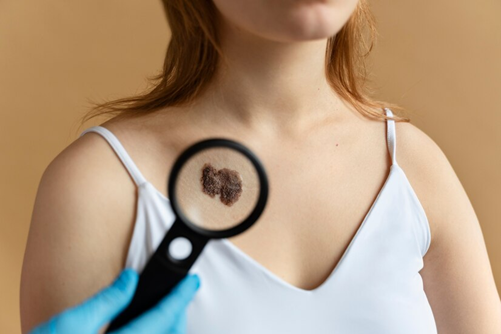In India, skin cancer is becoming increasingly common due to various factors. Many people are unaware of skin cancer’s prevalence and impact. By spreading knowledge about prevention and symptoms, we can empower everyone to take lifesaving actions. Awareness is key to tackling this growing concern. The effort to inform the public is significant, allowing for timely detection and reducing skin cancer cases. Let’s explore how understanding and awareness can lead to effective prevention and treatment.
Understanding and Preventing Skin Cancer
The sun emits UVA and UVB rays, both harmful to your skin. These rays can lead to skin cancer over time and cause noticeable skin damage. However, following simple prevention strategies can help protect you. Always use sunscreen that suits your skin, ensuring it blocks both UVA and UVB rays. Choose an SPF rating that’s at least 30 for effective protection.
Additionally, try to avoid direct sun exposure between 10 a.m. and 4 p.m., when the sun’s rays are strongest. Wear hats and sunglasses to shield your face and eyes. Regular skin checks are crucial for early detection. At home, examine moles or spots on your skin regularly for any changes. Look for alterations in color, size, or shape. This practice can alert you to issues before they become serious.
Outdoor Activities and Skin Cancer: Staying Safe under the Indian Sun
India’s beautiful outdoors and sunny climate are ideal for activities. However, they also mean increased skin cancer risks. Whether you’re watching a cricket match or enjoying a beach outing, it’s vital to stay safe. Always wear protective clothing. Light, long-sleeve shirts and wide-brim hats offer additional protection.
Choose sunscreen that’s suitable for Indian skin and weather conditions. Reapply it every two hours, especially if you’re swimming or sweating. Consider staying in shaded areas when spending extended periods outdoors. Following these tips ensures you enjoy sun-filled activities without worries.
Recognizing Skin Cancer: Symptoms and Early Detection
There are several skin cancer types to be aware of:
- Melanoma: Often appears as a new, unusual mole or changes to existing moles.
- Basal Cell Carcinoma (BCC): Usually appears as a bump or growth that’s pearly or waxy.
- Squamous Cell Carcinoma (SCC): Often looks like a red, scaly patch or a sore that heals and then reopens.
When assessing your skin, check for irregular borders, varying colors, and growth over time. Regular month-end reviews of your skin can be lifesaving. Prompt attention to new or changing spots is essential.
Exploring Treatments: Modern Approaches and Innovations
If detected, various treatments exist for skin cancer. Surgical methods, like Mohs surgery, precisely remove cancerous tissues layer by layer, minimizing damage to surrounding healthy skin.
Non-surgical options include photodynamic therapy, which uses light and special medications to eliminate cancer cells. Topical treatments may also be applied directly to cancerous areas. In addition, innovative international treatments are also available. In some cases, advanced treatments overseas may also be considered, offering hope and solutions to those affected.
Conclusion: Proactive Steps and Future Directions
The fight against skin cancer involves prevention, early detection, and a range of treatments. Empowering yourself with knowledge is a proactive, lifesaving action. Always remember to protect your skin and monitor changes. For expert dermatological care and skin cancer screenings, consider Shishira Hospitals. Publications and resources on international collaborations ensure advancements in skin cancer research continue to evolve. Stay informed, stay protected, and encourage ongoing education and research in the field of skin cancer prevention and treatment.





